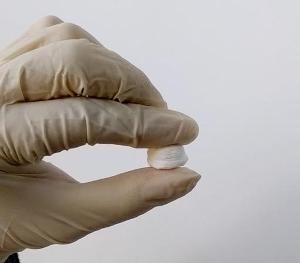Jun 5 2017
Ceramic materials are likely to shatter when they are deformed, however latest research demonstrates a technique of using ultra-thin ceramic nanofibers in order to make heat-resistant, squishy sponges with a wide range of potential applications.
 Nanofiber ceramics: Researchers from Brown and Tsinghua Universities have developed sponge-like materials made from ceramic nanofibers. The materials could be useful in a variety of applications, from insulation to water purification.Gao/Li/Wu/Brown/Tsinghua
Nanofiber ceramics: Researchers from Brown and Tsinghua Universities have developed sponge-like materials made from ceramic nanofibers. The materials could be useful in a variety of applications, from insulation to water purification.Gao/Li/Wu/Brown/Tsinghua
Researchers have discovered a way to produce ultralight sponge-like materials from nanoscale ceramic fibers. The compressible, highly porous and heat-resistant sponges could find several applications ranging from flexible insulating materials to water purification devices.
The basic science question we tried to answer is how can we make a material that’s highly deformable but resistant to high temperature. This paper demonstrates that we can do that by tangling ceramic nanofibers into a sponge, and the method we use for doing it is inexpensive and scalable to make these in large quantities.
Professor Huajian Gao, Brown University’s School of Engineering and a Corresponding Author of the research
This work, described in the journal Science Advances, is a collaboration between Gao’s lab at Brown and the labs of Hui Wu and Xiaoyan Li at Tsinghua University in China.
Individuals who have dropped a flower vase would obviously be aware of the fact that ceramics are brittle materials. Cracks in ceramics tend to propagate quickly, resulting in catastrophic failure with even the smallest type of deformation. This is true in the case of traditional ceramics, however things are indeed different at the nanoscale.
At the nanoscale, cracks and flaws become so small that it takes much more energy to activate them and cause them to propagate. Nanoscale fibers also promote deformation mechanisms such as what is known as creep, where atoms can diffuse along grain boundaries, enabling the material to deform without breaking.
Professor Huajian Gao, Brown University’s School of Engineering and a Corresponding Author of the research
Materials developed from ceramic nanofibers are capable of being flexible and deformable, due to those nanoscale dynamics, while maintaining the heat resistance that allow ceramics to be used in high-temperature applications. The issue here is that such materials are difficult to produce. Electrospinning, is one frequently used method of making nanofibers, but it does not work well with ceramics. 3D laser printing is another potential option but it is time-consuming and expensive.
The Researchers thus used a method known as solution blow-spinning, which was earlier developed by Wu in his lab at Tsinghua. In this method, air pressure is used to drive a liquid solution with ceramic material via a small syringe aperture. As the liquid comes out, it rapidly solidifies into nanoscale fibers that are then collected in a spinning cage. This is followed by heating of the collected material, which burns away the solvent material leaving behind a mass of tangled ceramic nanofibers that slightly resemble a cotton ball.
The method was used by the Researchers to develop sponges produced from a wide range of ceramics. The Researchers thus proved that the materials had few outstanding properties.
For instance, the sponges were able to rebound following a compressive strain up to 50%, a thing that cannot be achieved by any standard ceramic material. The sponges were able to maintain that resilience at temperatures up to 800 °C.
The research also demonstrated that the sponges had an excellent capacity for high-temperature insulation. The Researchers, in one particular experiment, placed a flower petal on top of 7 mm thick sponge developed from titanium dioxide (a common ceramic material) nanofibers. The flower on top hardly wilted after heating the bottom of the sponge to 400 °C for 10 minutes. In the meantime, petals placed on various other types of porous ceramic materials under the similar conditions were burnt to a crisp.
The deformability of the sponges and the heat resistance make them potentially useful as an insulating material where flexibility plays a vital role. For instance, Gao highlights the possibility of using the material as an insulating layer in clothing used by Firefighters.
Another promising use can be seen in water purification. Titanium dioxide is a photocatalyst recognized for breaking down organic molecules, which kills bacteria and various other microorganisms present in water. The Researchers demonstrated that a titanium dioxide sponge is capable of absorbing 50 times its weight in water containing an organic dye. The sponge degraded the dye under illumination within 15 minutes. With the water wrung out, it was then possible to reuse the sponge — something that can be attained with the titanium dioxide powders generally used in water purification.
Besides these, there are several other applications for ceramic sponges that the Researchers are yet to consider.
“The process we used for making these is extremely versatile; it can be used with a great variety of different types of ceramic starting materials,” said Wu, one of the Corresponding Authors from Tsinghua. “So we think there’s huge prospect for potential applications.”
The National Basic Research Program of China, the National Natural Science Foundation of China, the Chinese Program for New Century Excellent Talents in University and the U.S. National Science Foundation (CMMI-1634492) supported this work.